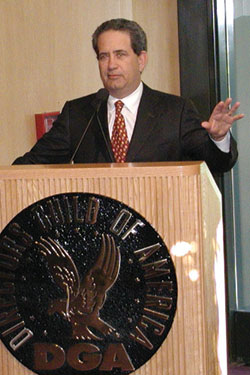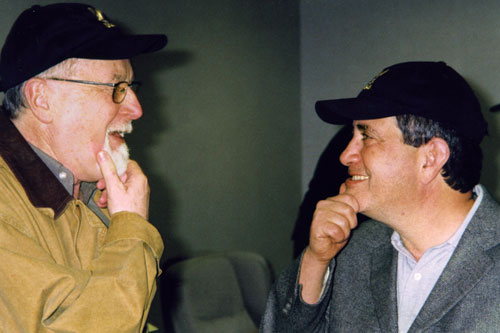 INTO THE FUTURE: National Executive Director Jay D. Roth
INTO THE FUTURE: National Executive Director Jay D. Roth brought a new level of sophistication to meeting
the needs of the membership.
The Directors Guild of America is an international labor organization with a staff of 140, a dozen departments, a national headquarters in Los Angeles, offices in New York and Chicago, and governing bodies drawn from its 14,500 members in the U.S. and around the world. This wasn't always the case. The evolution of the Guild from 1936 to the present day can most easily be seen as a continuum taking place over three distinct eras. The first began in the late 1930s with the establishment of the Guild. This ran through the late 1970s when a period of modernization began. The third and present era started in 1995 with a significant expansion of our approach to representation, organizing and member service.
"It's a members' organization, but it's the staff that keeps continuity and keeps focus and makes sure things get done," Past DGA President Michael Apted said. "Our members are and always have been busy people who are often off doing jobs, and the staff has been the rock on which the Guild is built, it's the stability and continuity that the organization was founded on."
The foundation of the Guild was set in the first era when, over the course of nearly 40 years, the staff evolved from one secretary, Elizabeth Berger, at its small offices in Crossroads of the World on Sunset Boulevard, to no more than a dozen employees by the mid-'70s. This was a period where cornerstones of current Guild service were laid, under the leadership of the founders and key staff who oversaw the first contract negotiations, setting creative rights milestones, instituting the pension and health plans, establishing residuals, coordinating the merger between directors on the East and West coasts, bringing the AD/UPM and AD/SM categories into the Guild, construction of the first DGA headquarters building in Los Angeles, and the acquisition of the Guild's New York offices.
Early Guild executives were mostly members who assumed the top administrative duties, including J.P. McGowan, Vernon Keays and William S. Holman. Joe Youngerman, an assistant director, took over as National Executive Secretary in 1950 and held the office for 27 years, earnings the nickname, "Mr. Guild." In 1950, the SDG had about 900 members and the full-time staff had grown to three - Youngerman, an office manager and Mabel Walker Willebrandt, an attorney who served as General Counsel.
|
|
|
FROM TOP: National Executive
Secretary Joe Youngerman,
National Executive Director Glenn
Gumpel, National Executive
Secretary Michael Franklin
|
Under Youngerman, the staff expanded to a dozen, including a bookkeeper, the first field rep and switchboard operator by the time the original Guild headquarters was built in 1955. After the Screen Directors Guild and Radio and Television Directors Guild merged to create the DGA in 1960, executives were assigned in Los Angeles, New York and Chicago to handle assistant directors and unit production managers, as well as associate directors and stage managers. Still, no departments existed, nor would they until the late 1970s. Although the Guild ran effectively, there were concerns from the National Board that the Guild was becoming anachronistic in its approach to meeting core functions, particularly residuals collection and contract enforcement.
Some leading board members, chief among them President Robert B. Aldrich, challenged the status quo in the mid-'70s and urged the DGA to modernize, especially as membership continued to grow rapidly on both coasts, rising from 3,300 members in 1967 to nearly 5,500 in 1977. Joe Youngerman retired in 1978, and Michael Franklin was hired as national executive secretary. Franklin, a lawyer who had worked in business affairs at CBS-TV and served as Executive Director of the Writers Guild of America west, moved quickly to bolster the Guild's services.
With the advent of new businesses like home video and the development of studios from independent entities to large corporations, Franklin knew the Guild had to respond to the challenges and, with board approval, he created several new departments including legal, residuals, membership and signatories. This required added staff and, by the end of Franklin's tenure in 1987, when the Guild's membership exceeded 8,000, the DGA had about 85 employees in Los Angeles, New York and Chicago. It was also in this period that the DGA, in 1978, achieved the ability to enforce its contracts through the arbitration and the grievance process. Franklin's successor, Glenn Gumpel, came aboard as National Executive Director (as the title was renamed in 1983) in 1988 and continued this process through 1995, as the Guild's membership approached 10,000. He was the executive when the Guild moved into its
current headquarters in Los Angeles in 1989.
The current era, under the leadership of National Executive Director Jay D. Roth, has seen a concerted effort to raise the sophistication and effectiveness of the Guild's approach to its core functions: representing members in collective bargaining, organizing and jurisdiction, and member support. The Guild got its first Credits Department, which has assisted all members of the directorial team in enforcing contracts' credit criteria for film and television, and an Organizing Department to address specialized types of work including independent film, reality television, and commercial work. In addition, an executive was assigned to address the lack of women and ethnic minorities hired by the industry and work with our committees and councils to affect change in this area. A Government Affairs office, working with a newly formed, member-driven Political Action Committee, was created to examine the impact of local, state and national legislation and the effect of those laws on our membership.
A Research Department monitors the entertainment industry's new technological and economic developments so that the Guild can be ahead of the curve when going into negotiations on behalf of the membership. The Guild also completed a four-year project to convert its legacy computer database systems (originally developed in the early 1980s) into a single, streamlined system to track and record projects, residuals, credits, membership and other vital data. A Communications Department keeps members well informed through the DGA Monthly member magazine and the DGA Quarterly craft journal and, most recently, the Guild completely revamped its website, www.dga.org.
 JOB WELL DONE: National Executive Director Jay D. Roth
JOB WELL DONE: National Executive Director Jay D. Roth (right) and Negotiating Committee Chairman Gil Cates
after the 2005 Basic Agreement was signed.
"Jay Roth is the very best of the breed of executive directors," said Secretary-Treasurer Gilbert Cates said. "Savvy technically, an ex-labor lawyer, he knows both his job and the fact that the membership, through its board and elected leaders, makes policy. He is a defender of the Guild's basic mission, which is to make things better for its members."
Since its inception, the DGA has expanded its jurisdiction well beyond feature film to include episodic television, documentaries, movies for television, commercials, daytime serials (soap operas), musical variety, news, sports, children's programming and reality television. Through the leadership of members and staff, advances continue to be made in each of these genres to protect and improve members' economic and creative rights.
"Our charge from the president and the board is to maintain the highest professional level of representation and service," Roth said. "We constantly challenge ourselves and the organization to be second to none."